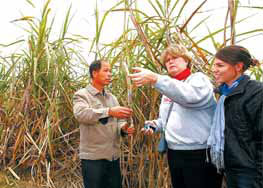Coca-Cola gets real about water conservation
|
Coca-Cola employees in a sugarcane field in the Guangxi Zhuang autonomous region. With the region in South China being the primary source of cane sugar for Coca-Cola, in 2011 the company worked with the local government to launch a model program for sustainable agriculture there, China's major cane sugar producing area. Provided to China Daily |
Coca-Cola Greater China has released its corporate social responsibility report in Beijing.
The fourth edition of the the Coca-Cola China System Sustainability Report, 2010-2011, was about the US company's activities in four core areas. They were water resource management, energy efficiency management and responses to climate change, sustainable packaging and a healthy community.
"In the period between the release of the first sustainability report in 2006 and 2011 year-end, Coca-Cola Greater China has made huge investments in sustainability, including countable investment alone of more than 230 million yuan ($36.2 million)," said Bai Changbo, vice-president for public affairs and communications at Coca-Cola Greater China.
"In terms of environmental protection, Coca-Cola is the first to announce the goal of 'water balance'. We are also the first in the beverage industry in China to announce the use of non-PVC labels. As far as the community is concerned, we have been for many years committed to public health, children's education, women's development and we support efforts to help disadvantaged groups.
Zhang Huaying, sustainability vice-president of Coca-Cola Greater China, said: "These efforts have helped hundreds of thousands of children improve their lives and schooling conditions and helped millions of people change to healthier lifestyles."
Water is one of the key parts of Coca Cola's sustainability strategy. At the global level, Coca-Cola says it has a core goal of achieving a "water balance" in its operations, which requires the company in its overall management and project investments to make reparation to the environment and the community to ensure that water resources remain equal to water consumed in production.
Under this vision, Coca-Cola says it has both improved its water resources management system in production and operational procedures and vigorously led its partners in the upstream and downstream industry chain to jointly participate in its water resources protection plan, as well as actively cooperating with government authorities and non-governmental organizations.
In 2011, the water resources efficiency of Coca-Cola China System increased by 38.4 percent as compared with the figure in 2004, beating its goal of increasing by 20 percent by 2020.
Also in 2011, the bottling system of Coca-Cola China recycled 16.4 percent of the water it used in production, an amount equal to the water used by 300,000 households in one month. Coca-Cola was the first in China's beverage industry to launch a trial "zero discharge" program.
Since March 22, 2011, Zhengzhou Taigu Coca-Cola Beverages has processed 200,000 tons of industrial wastewater for use as irrigation for trees and grass as a substitutes for tap water in urban green belt areas in the high-tech zone in Zhengzhou. Zhengzhou residents' water, after being recycled, can satisfy the needs of at least 4,760 residents for a year.
In addition to maintaining strict control over its own operations, Coca-Cola also supports a number of NGOs in a variety of water resource reparation programs.
Since 2007, Coca-Cola has worked with the United Nations Development Program, the Ministry of Water Resources and the Ministry of Commerce in the launch of the Water Resources Management Program in China's Rural Areas to help solve drinking water problems in China's countryside.
With Guangxi Zhuang autonomous region being the primary source of cane sugar for Coca-Cola, in 2011 the program worked with the local government to launch a model program for sustainable agriculture there, China's major cane sugar producing area.
By adopting a variety of approaches to improve water efficiency - for example, optimizing the use of irrigation facilities - the program has improved irrigation to almost 550 hectares of farmland. More than 5,000 sugar cane farmers have directly benefited from the programs. There are more than 100,000 indirect beneficiaries.
As for protection of headwaters, Coca-Cola and the World Wildlife Fund have worked together to protect the Yangtze River basin since June 2007.
From 2007 to 2010, the program carried out headwaters protection in 25 wetland nature reserves in the Jialing River basin. Thanks to river channel protection, public education and policy publicity, the lives of more than 4 million people have been positively influenced, while more than 500 million liters of clean water have returned to the area and to local communities.
From 2011 to 2013, the program plans to protect and recover 300,000 hectares of wetland and forest in upstream areas of the Yangtze River and attain the goal of returning 1 billion liters of water to nature and local residents.
"China's 12th Five-Year Plan (2011-15) prescribes that persistent efforts should be made to build a resources-efficient and environmentally friendly community to transform economic development. Under this guideline and in view of its business characteristics, Coca-Cola found its own path for sustainable development. We will continue to pursue sustainable development, boost investment in infrastructure and carry out sustainability programs so as to fulfill our commitment to China," added Bai.
Since re-entering China in 1979, Coca-Cola has invested more than $5 billion in the local market, including $3 billion from 2009 to 2011. By the end of March 2012, Coca-Cola had established a total of 42 bottling plants in China. Now the Coca-Cola system employs more than 50,000 people, 99 percent of which are local hires.
liwoke@chinadaily.com.cn

























